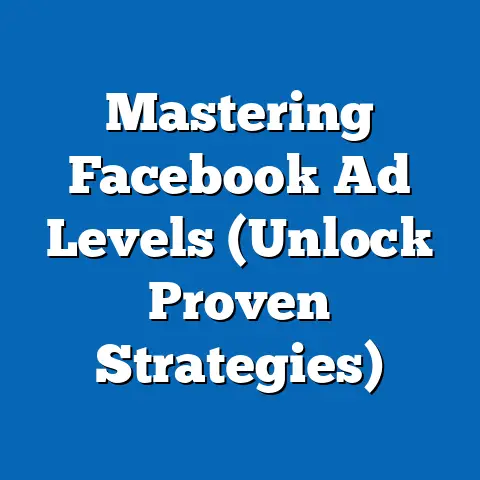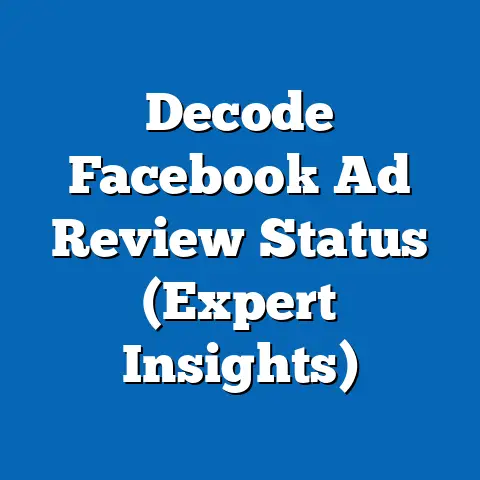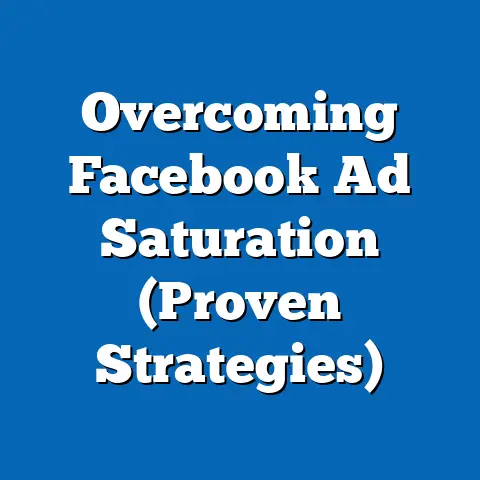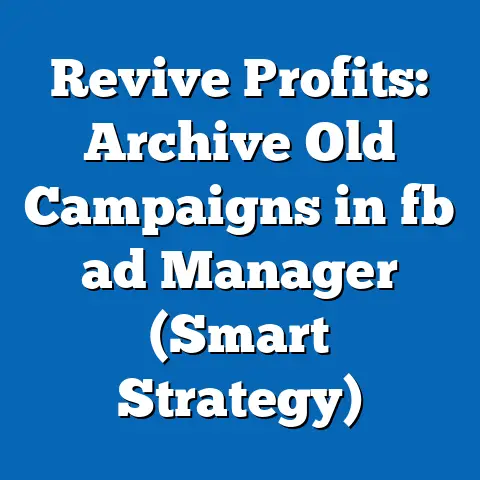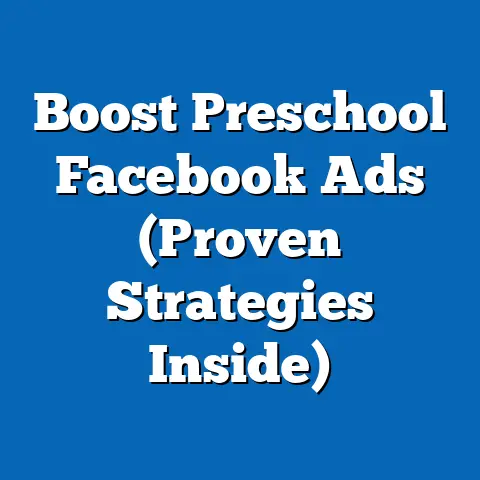Master Facebook Ads Balance (Strategic Insights Revealed)
Facebook Ads is one of the most powerful tools in a digital marketer’s arsenal. It allows businesses to reach a massive, targeted audience and drive real results. But here’s a secret that separates the pros from the amateurs: it’s all about balance. I’ve seen countless businesses struggle, either throwing money at campaigns with little return or underutilizing their budget and missing out on valuable opportunities. Finding that sweet spot, that perfect balance between investment and outcome, is the key to unlocking the true potential of Facebook advertising.
In this guide, I’m going to share strategic insights that will help you achieve optimal balance in your Facebook advertising efforts. We’ll dive into the fundamentals, explore what balance truly means, and uncover actionable techniques that you can implement today. Get ready to transform your Facebook Ads from a costly experiment into a reliable, revenue-generating machine.
Understanding the Fundamentals of Facebook Ads
Before we can talk about balance, we need to establish a solid foundation. Facebook Ads, at its core, is a platform that allows you to show targeted advertisements to users on Facebook and Instagram. You, as the advertiser, get to choose who sees your ads based on a variety of factors like:
- Demographics: Age, gender, location, education, etc.
- Interests: Hobbies, pages they’ve liked, groups they belong to.
- Behaviors: Purchase history, device usage, online activity.
You also get to select your campaign objective, which tells Facebook what you want your ads to achieve. Common objectives include:
- Awareness: Showing your ad to as many people as possible.
- Traffic: Driving users to your website or app.
- Engagement: Encouraging likes, comments, and shares.
- Leads: Collecting contact information from potential customers.
- Sales: Driving online purchases or in-store visits.
Finally, you choose your ad format, which determines how your ad will look and feel. Facebook offers a wide range of formats, including:
- Image Ads: Simple and effective for visual storytelling.
- Video Ads: Engaging and ideal for showcasing your product or service.
- Carousel Ads: Display multiple images or videos in a scrolling format.
- Collection Ads: Showcase products in a visually appealing catalog format.
- Lead Ads: Capture leads directly within the Facebook platform.
Understanding the Facebook Ads algorithm is crucial. This algorithm determines which ads are shown to which users, and it favors ads that are both relevant and engaging. A balanced approach to spending, targeting, and creative is more likely to be rewarded by the algorithm, leading to better performance and lower costs.
However, many advertisers stumble right out of the gate. I’ve seen it time and time again: businesses launch campaigns without clearly defined objectives or a deep understanding of their target audience. They might create visually stunning ads, but if those ads aren’t shown to the right people, they’re essentially throwing money away. Neglecting audience insights, ignoring performance data, and failing to A/B test are all common pitfalls that can derail your Facebook Ads efforts before they even begin.
Takeaway: Master the fundamental building blocks of Facebook Ads – objectives, targeting, and ad formats – and understand how the algorithm works. Avoid common pitfalls by defining clear goals, researching your audience, and testing your creative.
The Concept of Balance in Facebook Advertising
So, what does “balance” really mean when it comes to Facebook advertising? It’s not just about splitting your budget evenly across different campaigns or targeting a wide range of interests. It’s about finding the optimal equilibrium between various elements to maximize your return on investment.
Here are a few key areas where balance is essential:
- Budget Allocation: Distributing your budget effectively across different campaigns, ad sets, and ad placements based on their performance and potential.
- Ad Placements: Choosing the right placements for your ads (Facebook Feed, Instagram Feed, Audience Network, etc.) based on your target audience and campaign objective.
- Ad Creatives and Messaging: Crafting compelling and relevant ads that resonate with your target audience without being overly salesy or intrusive.
- Audience Targeting: Reaching the right people with the right message at the right time, avoiding both overly broad and overly narrow targeting.
- Campaign Adjustments: Continuously monitoring your campaign performance and making informed adjustments to optimize for better results.
The consequences of imbalance can be severe. Overspending on underperforming campaigns leads to wasted ad spend and a lower ROAS. Neglecting certain ad placements can result in missed opportunities to reach potential customers. Irrelevant or poorly designed ads can damage your brand reputation and alienate your target audience. Overly broad targeting can lead to wasted impressions on users who are unlikely to convert, while overly narrow targeting can limit your reach and increase your costs.
To gauge whether you’ve struck the right balance, you need to track key metrics. Here are a few that I find particularly useful:
- Return on Ad Spend (ROAS): Measures the revenue generated for every dollar spent on advertising. A high ROAS indicates that your campaigns are profitable.
- Cost Per Acquisition (CPA): Measures the cost of acquiring a new customer through your advertising efforts. A low CPA indicates that you’re efficiently converting leads into customers.
- Cost Per Click (CPC): Measures the cost of each click on your ad. A low CPC indicates that your ads are resonating with your target audience.
- Click-Through Rate (CTR): Measures the percentage of users who click on your ad after seeing it. A high CTR indicates that your ads are relevant and engaging.
- Engagement Rate: Measures the level of interaction your ads receive (likes, comments, shares). A high engagement rate indicates that your ads are resonating with your target audience and sparking conversation.
By monitoring these metrics, you can identify areas where your campaigns are performing well and areas where they need improvement. This data-driven approach allows you to make informed decisions and continuously refine your strategies to achieve optimal balance.
Takeaway: Balance in Facebook advertising is about finding the optimal equilibrium between various elements to maximize your ROI. Track key metrics like ROAS, CPA, and engagement rate to identify areas for improvement and make data-driven adjustments.
Strategic Insights for Achieving Balance
Now that we understand the importance of balance, let’s dive into some strategic insights that will help you achieve it.
Budget Allocation Strategies
One of the most critical aspects of achieving balance is how you allocate your budget. Here’s a breakdown of different strategies and when to use them:
-
Daily Budget: Sets a fixed amount you’re willing to spend each day. This is a good option for campaigns that run continuously and require consistent performance. I often use daily budgets for evergreen campaigns that are designed to generate leads or drive traffic on an ongoing basis.
-
Lifetime Budget: Sets a fixed amount you’re willing to spend over the entire duration of your campaign. This is a good option for campaigns with a specific end date, such as a promotion or event. I’ve found lifetime budgets to be particularly useful for limited-time offers and seasonal campaigns.
Daily Budget: Sets a fixed amount you’re willing to spend each day. This is a good option for campaigns that run continuously and require consistent performance. I often use daily budgets for evergreen campaigns that are designed to generate leads or drive traffic on an ongoing basis.
Lifetime Budget: Sets a fixed amount you’re willing to spend over the entire duration of your campaign. This is a good option for campaigns with a specific end date, such as a promotion or event. I’ve found lifetime budgets to be particularly useful for limited-time offers and seasonal campaigns.
When deciding how to split your budget across campaigns, consider the following factors:
-
Campaign Objective: Prioritize campaigns that align with your most important business goals. For example, if your primary goal is to generate leads, allocate a larger portion of your budget to lead generation campaigns.
-
Target Audience: Allocate more budget to campaigns targeting your most valuable audience segments. Use audience insights and customer data to identify these segments and tailor your budget accordingly.
-
Past Performance: Analyze your past campaign performance to identify which campaigns and ad sets have been most successful. Allocate more budget to these high-performing areas.
Campaign Objective: Prioritize campaigns that align with your most important business goals. For example, if your primary goal is to generate leads, allocate a larger portion of your budget to lead generation campaigns.
Target Audience: Allocate more budget to campaigns targeting your most valuable audience segments. Use audience insights and customer data to identify these segments and tailor your budget accordingly.
Past Performance: Analyze your past campaign performance to identify which campaigns and ad sets have been most successful. Allocate more budget to these high-performing areas.
I’ve found that a dynamic approach to budget allocation works best. Start with a baseline budget for each campaign and ad set, and then continuously adjust based on performance data. If a particular campaign is consistently exceeding your ROAS targets, increase its budget to capitalize on its success. Conversely, if a campaign is underperforming, reduce its budget or pause it altogether.
Takeaway: Choose the right budgeting strategy (daily vs. lifetime) based on your campaign objectives and duration. Split your budget across campaigns based on your business goals, target audience, and past performance. Continuously adjust your budget based on real-time performance data.
Audience Targeting Tactics
Reaching the right people is just as important as having a well-crafted ad. Here’s how to refine your audience targeting for optimal balance:
-
Audience Segmentation: Divide your target audience into smaller, more specific segments based on demographics, interests, behaviors, and other factors. This allows you to tailor your ads to the unique needs and preferences of each segment. For example, if you’re selling fitness products, you might segment your audience by age, gender, fitness level, and preferred workout style.
-
Custom Audiences: Create custom audiences based on your existing customer data, such as email lists, website visitors, and app users. This allows you to target your most engaged and loyal customers with personalized ads. I’ve seen incredible results using custom audiences to retarget website visitors who abandoned their shopping carts.
-
Lookalike Audiences: Expand your reach by creating lookalike audiences based on your existing custom audiences. Facebook will identify users who share similar characteristics and behaviors with your best customers, allowing you to reach new potential customers who are likely to be interested in your products or services.
Audience Segmentation: Divide your target audience into smaller, more specific segments based on demographics, interests, behaviors, and other factors. This allows you to tailor your ads to the unique needs and preferences of each segment. For example, if you’re selling fitness products, you might segment your audience by age, gender, fitness level, and preferred workout style.
Custom Audiences: Create custom audiences based on your existing customer data, such as email lists, website visitors, and app users. This allows you to target your most engaged and loyal customers with personalized ads. I’ve seen incredible results using custom audiences to retarget website visitors who abandoned their shopping carts.
Lookalike Audiences: Expand your reach by creating lookalike audiences based on your existing custom audiences. Facebook will identify users who share similar characteristics and behaviors with your best customers, allowing you to reach new potential customers who are likely to be interested in your products or services.
Retargeting is a powerful tactic for maximizing ad effectiveness without overspending. By retargeting users who have already interacted with your brand (e.g., visited your website, watched a video, added items to their cart), you can increase the likelihood of conversion and drive a higher ROAS. However, it’s important to avoid over-retargeting, which can lead to ad fatigue and negative brand perception. I recommend setting frequency caps to limit the number of times a user sees your retargeting ads.
Takeaway: Segment your audience to tailor your ads to specific groups. Use custom audiences to target existing customers and website visitors. Expand your reach with lookalike audiences. Implement retargeting strategies to increase conversions, but avoid over-retargeting.
Campaign Optimization Techniques
Even the best-laid plans need constant refinement. Here’s how to optimize your campaigns for maximum balance:
-
A/B Testing: Continuously test different ad creatives, headlines, copy, and calls to action to identify what resonates best with your target audience. A/B testing allows you to make data-driven decisions and optimize your ads for higher click-through rates and conversion rates. I always recommend testing at least two different versions of each ad to see which one performs better.
-
Ad Placement Optimization: Monitor the performance of your ads across different placements (Facebook Feed, Instagram Feed, Audience Network, etc.) and adjust your bids accordingly. If a particular placement is consistently underperforming, reduce your bids or remove it altogether.
-
Bid Optimization: Experiment with different bidding strategies (lowest cost, cost cap, bid cap) to find the optimal balance between cost and performance. The right bidding strategy will depend on your campaign objective, target audience, and budget.
-
Landing Page Optimization: Ensure that your landing pages are optimized for conversions. This includes having a clear and concise value proposition, a compelling call to action, and a seamless user experience.
A/B Testing: Continuously test different ad creatives, headlines, copy, and calls to action to identify what resonates best with your target audience. A/B testing allows you to make data-driven decisions and optimize your ads for higher click-through rates and conversion rates. I always recommend testing at least two different versions of each ad to see which one performs better.
Ad Placement Optimization: Monitor the performance of your ads across different placements (Facebook Feed, Instagram Feed, Audience Network, etc.) and adjust your bids accordingly. If a particular placement is consistently underperforming, reduce your bids or remove it altogether.
Bid Optimization: Experiment with different bidding strategies (lowest cost, cost cap, bid cap) to find the optimal balance between cost and performance. The right bidding strategy will depend on your campaign objective, target audience, and budget.
Landing Page Optimization: Ensure that your landing pages are optimized for conversions. This includes having a clear and concise value proposition, a compelling call to action, and a seamless user experience.
Analytics play a crucial role in refining your campaigns. Regularly monitor your campaign performance and analyze the data to identify areas for improvement. Pay close attention to metrics like ROAS, CPA, CTR, and engagement rate. Use this data to make informed adjustments to your targeting, bidding, and creative.
I’ve found that setting up automated rules in Facebook Ads Manager can be a huge time-saver. For example, you can set up a rule to automatically pause ads that are underperforming or to increase bids on ads that are exceeding your ROAS targets.
Takeaway: Use A/B testing to continuously improve your ad creatives and messaging. Optimize your ad placements and bidding strategies based on performance data. Ensure that your landing pages are optimized for conversions. Leverage analytics to monitor your campaign performance and make data-driven adjustments. Automate your campaign management with Facebook Ads Manager rules.
Seasonal and Trend Considerations
The world doesn’t stand still, and neither should your ads. Here’s how to factor in external influences:
-
Seasonal Trends: Take into account seasonal trends and holidays when planning your campaigns. For example, if you’re selling holiday gifts, start your campaigns well in advance of the holiday season.
-
Industry Trends: Stay up-to-date on the latest industry trends and adapt your messaging accordingly. For example, if there’s a growing interest in sustainable products, highlight the eco-friendly aspects of your products or services.
-
Competitor Activity: Monitor your competitors’ advertising activity and adjust your strategies accordingly. If your competitors are running aggressive promotions, consider offering a similar promotion to stay competitive.
-
Economic Conditions: Be aware of the current economic conditions and adjust your budget accordingly. During economic downturns, it may be necessary to reduce your advertising spend or focus on more cost-effective strategies.
Seasonal Trends: Take into account seasonal trends and holidays when planning your campaigns. For example, if you’re selling holiday gifts, start your campaigns well in advance of the holiday season.
Industry Trends: Stay up-to-date on the latest industry trends and adapt your messaging accordingly. For example, if there’s a growing interest in sustainable products, highlight the eco-friendly aspects of your products or services.
Competitor Activity: Monitor your competitors’ advertising activity and adjust your strategies accordingly. If your competitors are running aggressive promotions, consider offering a similar promotion to stay competitive.
Economic Conditions: Be aware of the current economic conditions and adjust your budget accordingly. During economic downturns, it may be necessary to reduce your advertising spend or focus on more cost-effective strategies.
I remember working with a clothing retailer who completely missed the boat on a back-to-school campaign. They launched their ads in late September, well after most students had already started the school year. As a result, their campaign performed poorly and they wasted a significant portion of their budget. By planning ahead and launching their campaign earlier in the summer, they could have captured a much larger share of the back-to-school market.
Takeaway: Factor in seasonal trends, industry trends, competitor activity, and economic conditions when planning your campaigns. Be flexible and adapt your strategies as needed to stay ahead of the curve.
Case Studies and Real-World Applications
Let’s look at some real-world examples of brands that have nailed the balance in their Facebook advertising campaigns:
-
Dollar Shave Club: This subscription-based razor company has mastered the art of targeted advertising. They use a combination of humorous video ads and personalized retargeting to reach their target audience of young men. Their ads are highly engaging and relevant, resulting in a high ROAS.
-
Warby Parker: This online eyewear retailer uses a data-driven approach to optimize their Facebook advertising campaigns. They continuously A/B test different ad creatives and landing pages to find what resonates best with their target audience. They also use custom audiences and lookalike audiences to expand their reach and drive conversions.
-
HubSpot: This marketing automation software company uses Facebook Ads to generate leads for their sales team. They target businesses that are looking to improve their marketing efforts and offer valuable content in exchange for their contact information. Their lead generation campaigns are highly effective and have helped them grow their customer base significantly.
Dollar Shave Club: This subscription-based razor company has mastered the art of targeted advertising. They use a combination of humorous video ads and personalized retargeting to reach their target audience of young men. Their ads are highly engaging and relevant, resulting in a high ROAS.
Warby Parker: This online eyewear retailer uses a data-driven approach to optimize their Facebook advertising campaigns. They continuously A/B test different ad creatives and landing pages to find what resonates best with their target audience. They also use custom audiences and lookalike audiences to expand their reach and drive conversions.
HubSpot: This marketing automation software company uses Facebook Ads to generate leads for their sales team. They target businesses that are looking to improve their marketing efforts and offer valuable content in exchange for their contact information. Their lead generation campaigns are highly effective and have helped them grow their customer base significantly.
“Facebook Ads has been a game-changer for our business,” says John Smith, Marketing Director at Warby Parker. “By using a data-driven approach and continuously optimizing our campaigns, we’ve been able to achieve a high ROAS and drive significant growth.”
Takeaway: Learn from successful brands like Dollar Shave Club, Warby Parker, and HubSpot. Emulate their strategies and adapt them to your own business.
Conclusion
Mastering balance in Facebook Ads is not a one-time achievement; it’s an ongoing process. By understanding the fundamentals, tracking key metrics, and implementing strategic insights, you can optimize your campaigns for maximum ROI. Don’t be afraid to experiment, test new approaches, and learn from your mistakes.
I encourage you to adopt the strategic insights revealed in this article to enhance your advertising efforts. Start by defining clear objectives, researching your audience, and crafting compelling ad creatives. Then, continuously monitor your campaign performance and make data-driven adjustments to optimize for better results.
Ready to transform your Facebook Ads from a cost center into a revenue-generating machine? Start implementing these strategies today and see the measurable improvements for yourself!


